Scoring is based on the number of questions you've answered correctly
and the time it took you
to complete the test.
You score 1 point for each correct answer.
You add or subtract points according to the following table:
20 minutes or less: add 3 bonus points
25 minutes: add 2 bonus points
30 minutes: add 1 bonus point
31 - 44 minutes: no bonus points
45 minutes or longer: subtract 3 points
1. Some collywobbles are geniunes.
All geniunes have six legs.
Therefore which of the following must be true?
(a) All collywobbles have six legs.
(b) All genuines are collywobbles.
(c) Some collywobbles have six legs.
(d) It can not be determined whether any of the above are true.
2. Insert the same four-letter word in both sets of blanks to make two words.
D O _ _ _ _
_ _ _ _ T A I N
3. Complete the series in the top row of figures with one of the lettered diagrams in the bottom row.
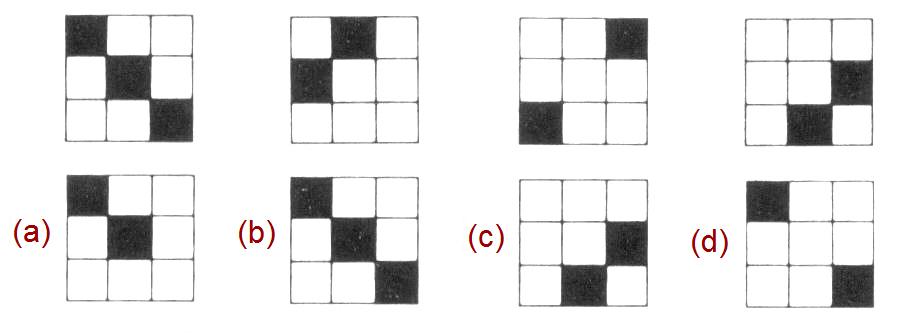
The position of each black square is moved one box at a time in a straight line,
disappears at the end of the square, then starts again in the same direction.
Consider the black square in each row separately (also look at each row separately).
In the first row, the square moves 1 block at a time to the right. When it gets to the end, it disappears and the comes back to the beginning.
So in picture 1, the square is in the first block. In picture 2, the square is in the second block. In picture 3, the square is in the third block.
In picture 4, the square disappears. Then in picture 5 (the answer), the square will be back in the first block.
Now consider the second row.
In the second row, the square moves 1 block at a time to the left. When it gets to the beginning, it disappears and the comes back to the end.
So in picture 1, the square is in the second block. In picture 2, the square is in the first block. In picture 3, the square disappears.
In picture 4, the square is in the third block. Then in picture 5 (the answer), the square will be back in the second block.
Now consider the third row.
In the third row, the square moves 1 block at a time to the right. When it gets to the end, it disappears and the comes back to the beginning.
So in picture 1, the square is in the third block. In picture 2, the square disappears. In picture 3, the square is in the first block.
In picture 4, the square is in the second block. Then in picture 5 (the answer), the square will be back in the third block.
4. Pick the numbers that most reasonably come next in the following series:
2 8 3 7 5 6
8 5 __ __
(a) 8 6
(b) 11 4
(c) 12 4
(d) 12 6
There are two alternating series.
Every other number, starting with 2, is increased by one, then by 2, then by 3, etc.
The second series, startng with the 8, is decreased by one.
5. Find a word that in one sense means the same as the phrase on the left
and in another sense means the same as the word on the right
RUN AWAY ____________ FASTENING
6. In this analogy,
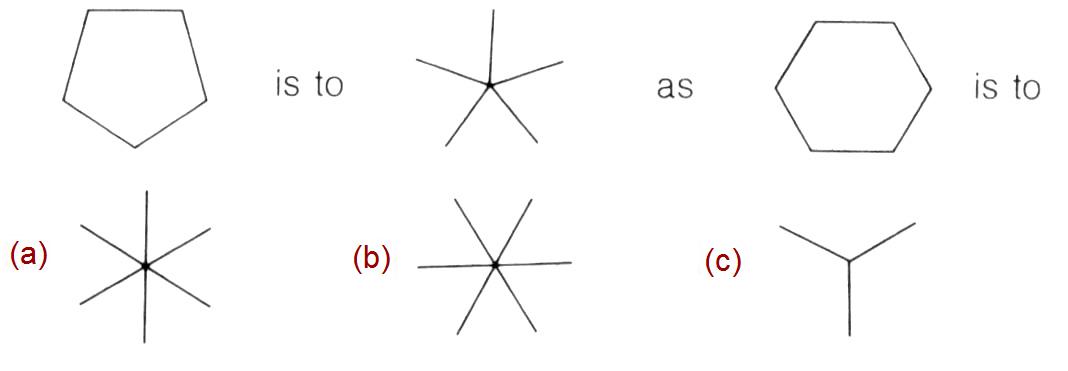
The lines are at right angles to the edges of the preceding figures.
7. Meg is younger than Beth.
Amy is older than Meg.
Jo is older than Amy.
Therefore (choose one):
(a) Amy is older than Beth.
(b) Beth is older than Amy.
(c) Meg is older than Jo.
(d) Jo is older than Meg.
8. Complete the analogy by entering a seven letter word ending in m:
Star is to constellation as petal is to _ _ _ _ _ _ _.
9. Which of the figures below csn be obtained by rotating the figure at far right?

10. What number, multiplied by 3, is three-fourths of 120?
Use algebra to solve: 3x = 3/4 (120)
11. Insert the same three-letter word in both sets of blanks below to make two sets of new words each.
(Example: Inserting the word ACT in F _ _ _ R E S S and in TR _ _ _ UAL
makes FACT, ACTRESS, TRACT, and ACTUAL.
P L _ _ _ L E R GR _ _ _ I Q U E
12. Alarming is to marginal as enraged is to
(a) angered
(b) dormant
(c) caustic
(d) belligerent
Alarming is an anagram of marginal;
enraged is an anagram of angered.
13. In this analogy,
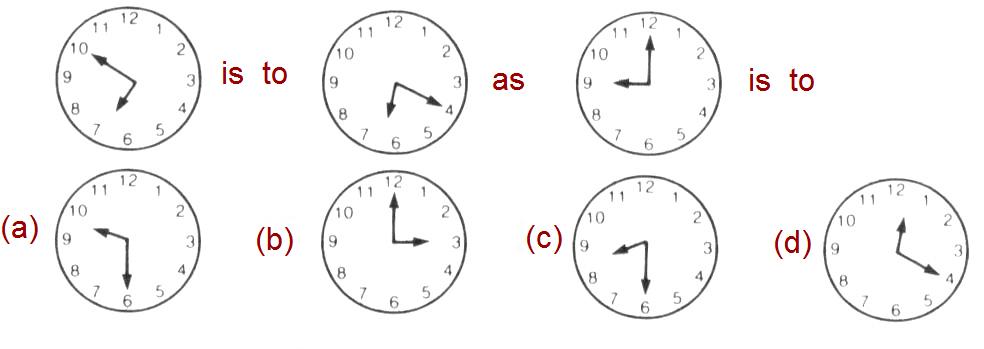
8:30 is half an hour earlier than 9:00.
14. If I III V = SAT, and IV III VI = RAY, and VI III II = YAM,
then what is I II III IV V ?
15. Jim has as many sisters as he has brothers,
but his sister has twice as many brothers as she has sisters.
How many boys and how many girls are there in the family?
16. All winkles are franchies.
All franchies are light blue.
Some franchies are hornswoggles.
Therefore (choose one):
(a) All winkles are light blue.
(b) All hornswoggles are winkles.
(c) Neither (a) nor (b) is true.
(d) Both (a) and (b) are true.
17. The numbers in the square at left, below, have been placed following a certain
mathematical rule. If the numbers in the square at the right
were placed following the same rule, what is the missing number?
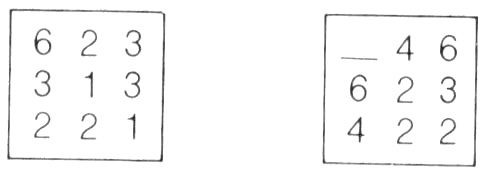
Look at the multiplication pattern in each COLUMN.
For each number in the top row, the 2 numbers below it are the factors (2x3=6, 2x1=2, 1x3=3).
This same pattern works in the second array of numbers, so 4x6=24)
18. In this analogy,

It's the area where the three figures overlap.
19. Think of a wooden cube measuring three inches on each side.
Imagine painting it red all over -- on the exposed surfaces.
If you now cut the cube into one-inch cubelets (there will be 27 of them),
how many will have paint on exactly two faces?
20. Capitalism is to entrepreneur as feudalism is to
(a) horse
(b) serf
(c) lord
(d) fief
An English teacher sent me the following explanation:
First, an entrepreneur is a person. So that makes me eliminate "horse" and "fief" as possibilities. A horse is obviously not a person, and a fief is not a person. A fief or fiefdom is land/property overseen/managed by a lord or baron in feudalism. I also eliminated "serf." Serfs were almost like slaves under feudalism. A lord or baron ruled a section of land (authorized/granted by the king) and the serfs were bound to that land of fief. They farmed that land and each year paid a tribute (rent, if you will) of a prescribed amount of grain, produce, etc., to the baron for the use of the land. They certainly weren't the ones in charge during feudalism or the ones who reaped the most benefit from the feudal system.
The word entrepreneur, however, suggests an owner or someone who takes a risk and begins his own business or company and then oversees that company. Therefore, for me, the entrepreneur in capitalism would be most analogous to the lord in feudalism. Just as a lord benefitted most from feudalism, an entrepreneur benefits most in capitalism.
21. Which set of letters logically comes next in the following series?
Z Y X U V W
T S R _ _ _
(a) O P Q
(b) P O Q
(c) O Q N
(d) N O Q
22. There are four houses in a row along a deadend street.
The Wilsons live next to the Joneses but not next to the Ronsons.
The Browns do not live next to the Ronsons.
Who are the Ronsons' next door neighbors?
(a) the Wilsons.
(b) the Joneses.
(c) the Wilsons and the Jones.
It cannot be determined from the information given.
23. Sally types 50 characters in 10 seconds.
Jane can type only 40 in the same time.
Working together, how long will it take them to type 360 characters?
24. Below are three views of the same cube.
Which of the four lettered patterns is opposite the blank white face of the third cube?
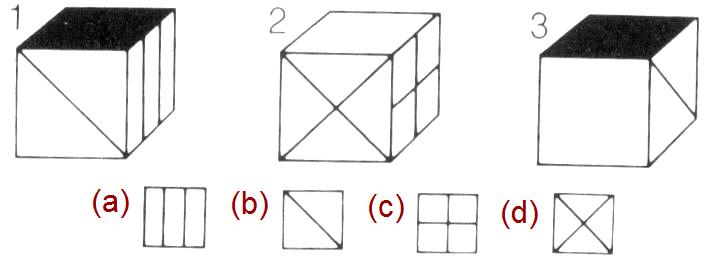
25. The number of dresses owned by Susan is the same number owned by Tess divided by the number owned by Jane.
Tess has 42 dresses and would own eight times as many as Jane if Tess had 14 more.
How many dresses does Susan have?
26. In this analogy,

The arrow appears at the left edge of the circle every time.
27. You buy an elephant for $5,500.
A traveling circus buys it from you for $5,500.
After the season, they sell it back to you for $5,000,
and you sell it to a zoo for $6,000.
How much money have you made or lost on this transaction?
28. What is the price of the last item below?
Leather $3.00
Linen $9.00
Sateen $10.00
Worsted $_____
"Worsted" contains the letters TWO, as each of the other words contains the letters of its corresponding number.
29. If A + B = 18, and A x B = 72, then A2 + B2 =
(a) 144
(b) 160
(c) 180
(d) 252
The two numbers are 6 and 12.
30. Below are four views of the same alphabet block,
which has a different letter on each of its six faces.
What is the missing letter in view d?

Actually, Carl T. Knox of Hampton, Minnesota pointed out that the orientation of the letters N, T, and E are not correct in figure (A), so I agreed and deemed the question invalid!
Howvever, two months later, another reader, Jason, sent the following:
"I recently tried writing the "Mensa Test #2" posted on your website, and noticed that the answer key for question #30 claimed that the orientation of letters on the first view of the cube was incorrect, which invalidated the question. I believe this correction is incorrect.
It is possible to construct a cube which satisfies the first three views as given, and provides a solution for the missing face on the fourth view. Although the question specifies that there is a different letter on each face, the question does not state that each side is visually unique, or that each side has a different image. The letters "N" and "Z" can appear visually identical when rotated, while still being technically 'different letters'.
I have attached an image of an unfolded cube which satisfies question #30. If printed, cut out, and folded into a cube, it can be rotated to show all four views given."

So, the question is valid and the answer is V. Thank you, Jason, for providing the image above.
31. "You can't judge a book by its cover" is closest in meaning to which of the following?
(a) People who live in glass houses shouldn't throw stones.
(b) Beauty is in the eye of the beholder.
(c) Where there's smoke, there's fire.
(d) All that glitters is not gold.
32. A man bets $30 and wins back his original wager plus $60.
He spends one-third of his new total on a present for his wife,
$10 for taxi fare home, and 10% of what is left to tip the driver.
How much does he have when he gets home?
33. Which of the figures can be obtained by reversing and rotating the figure at right?

Rotate clockwise 180 degress, then flip (reverse).